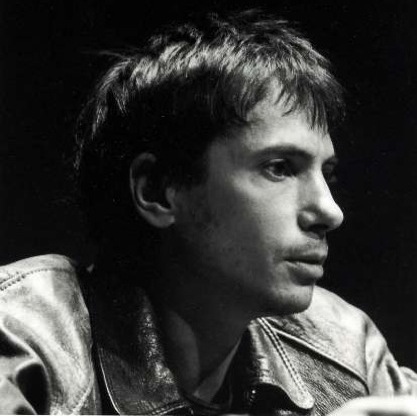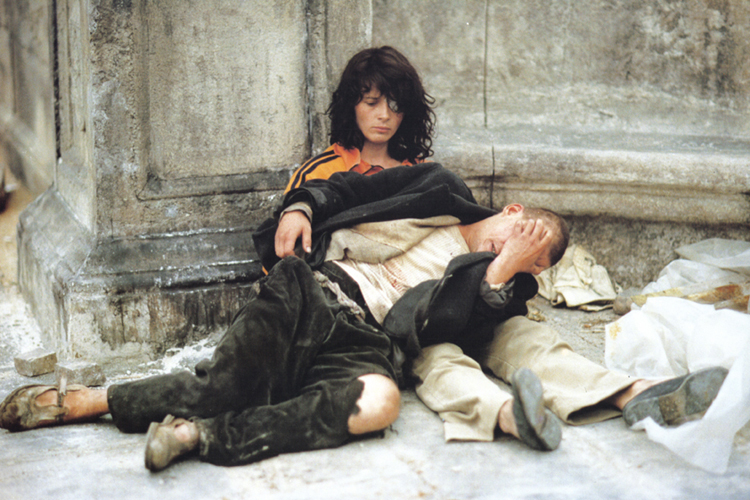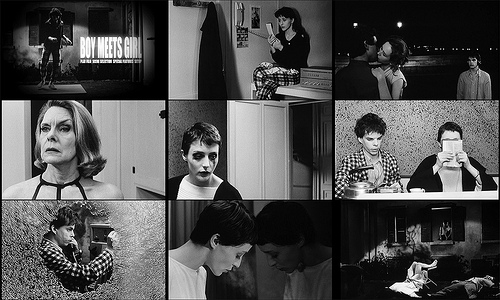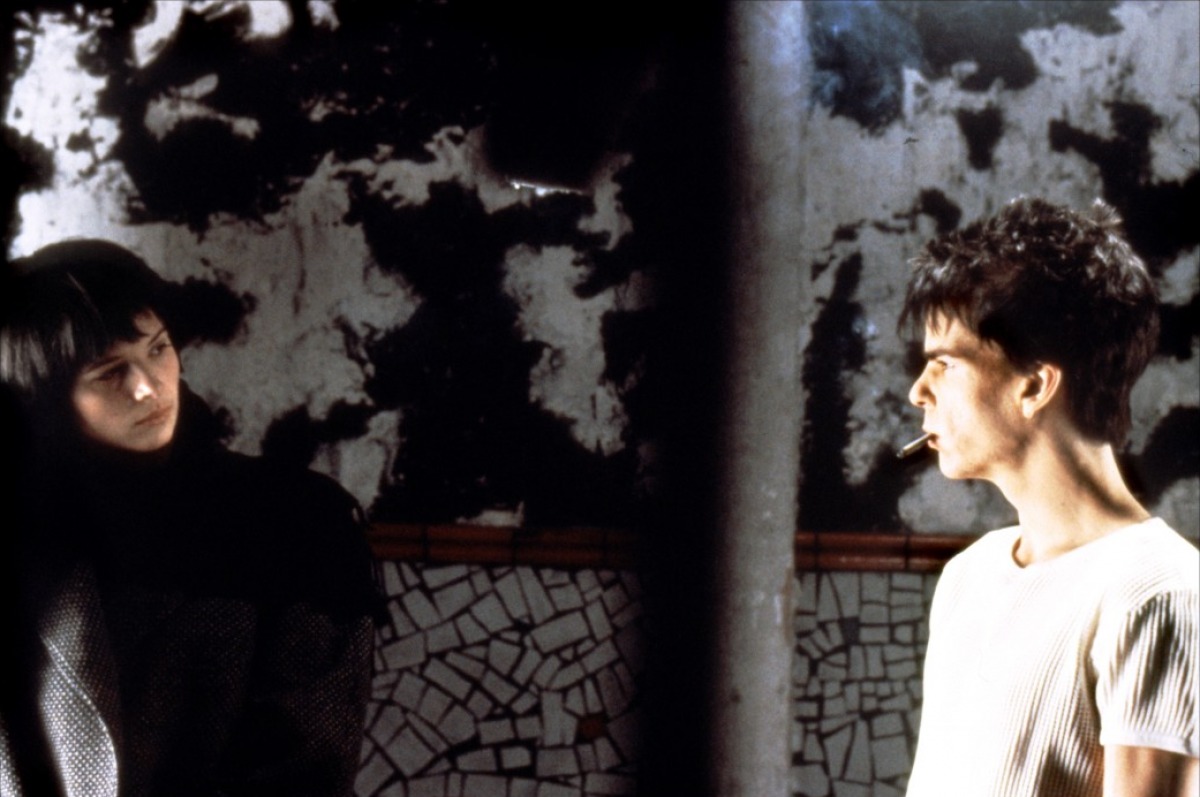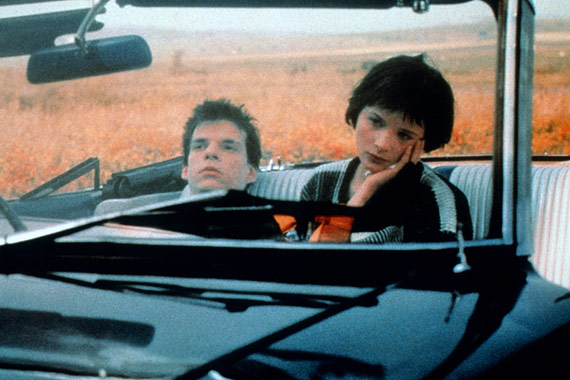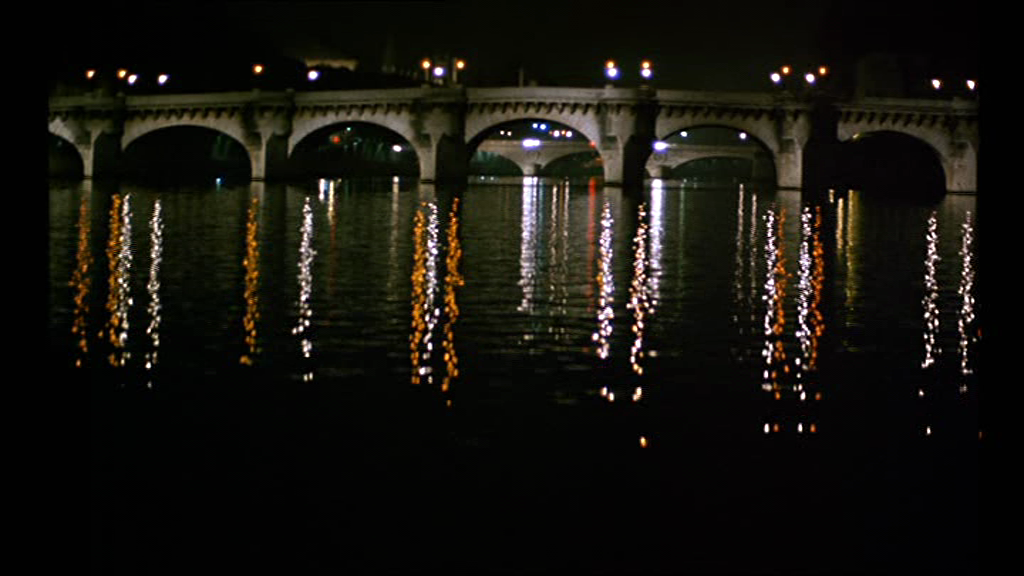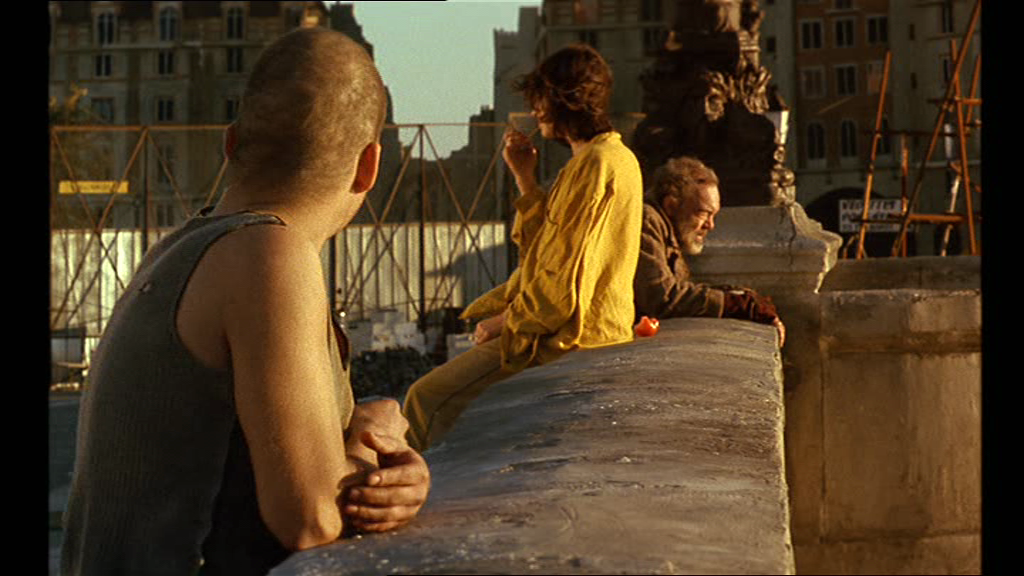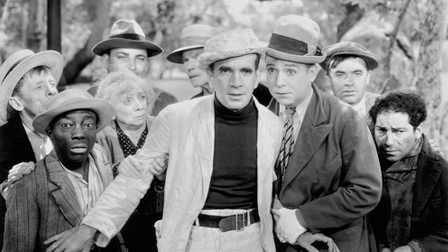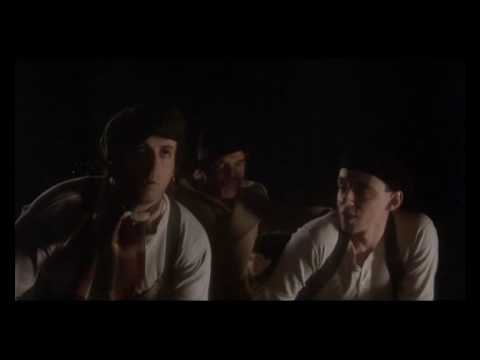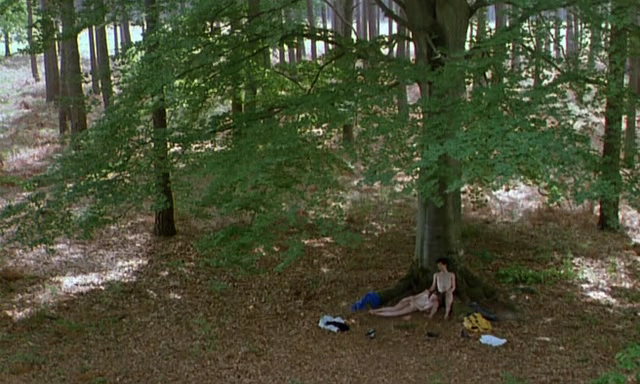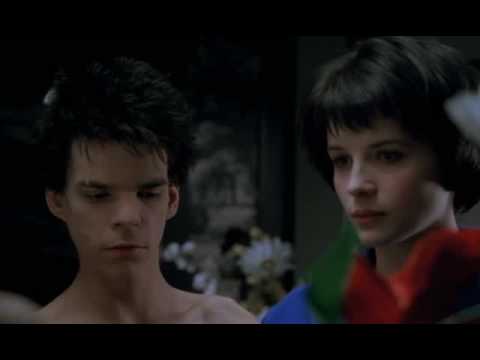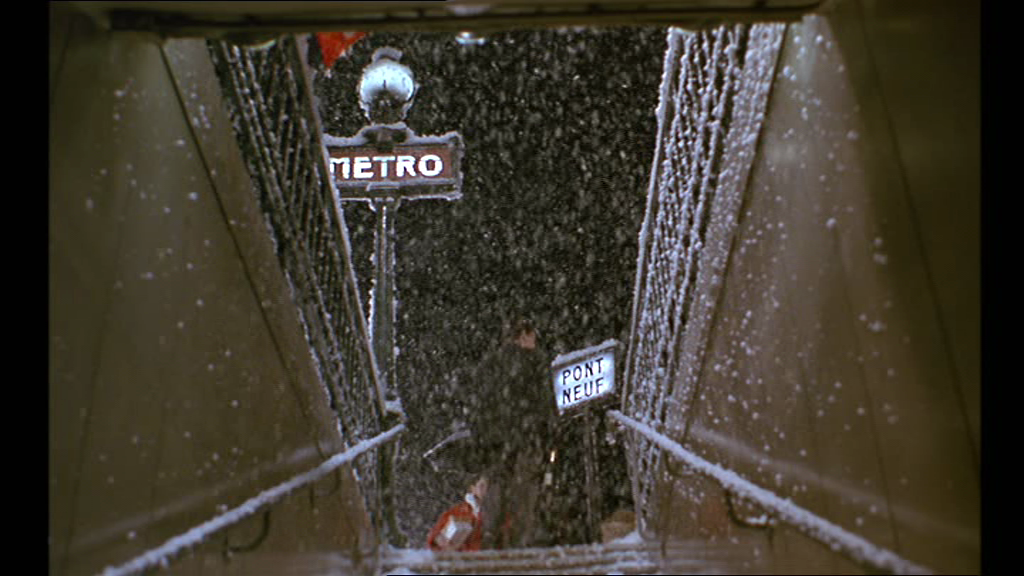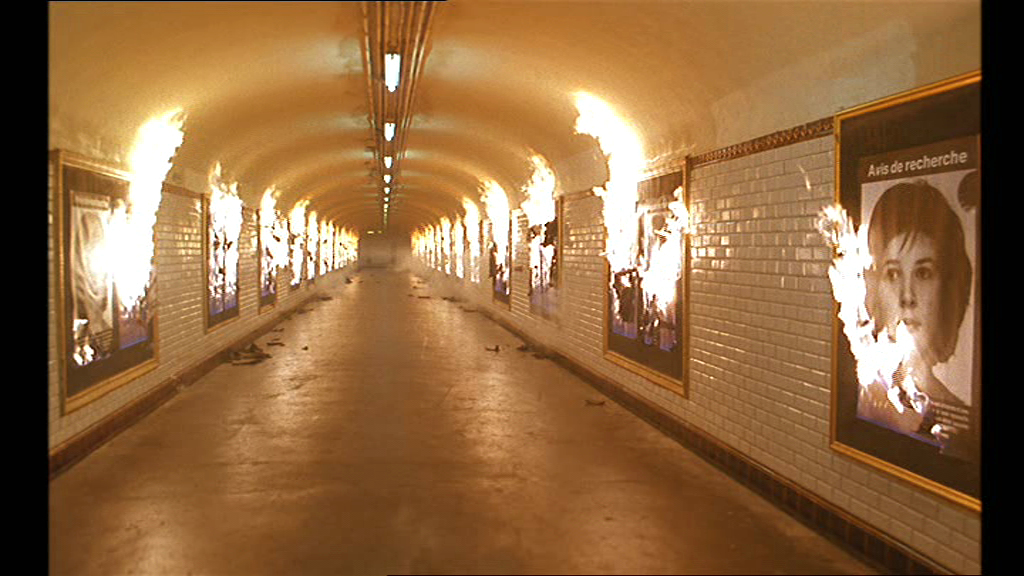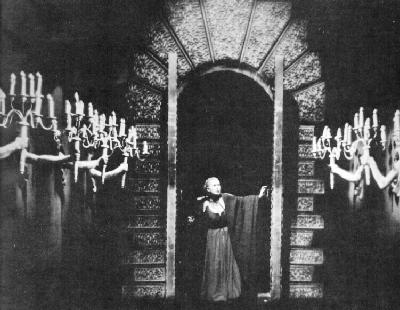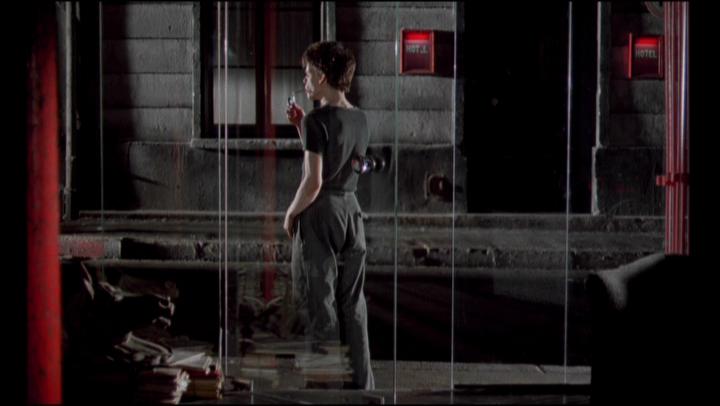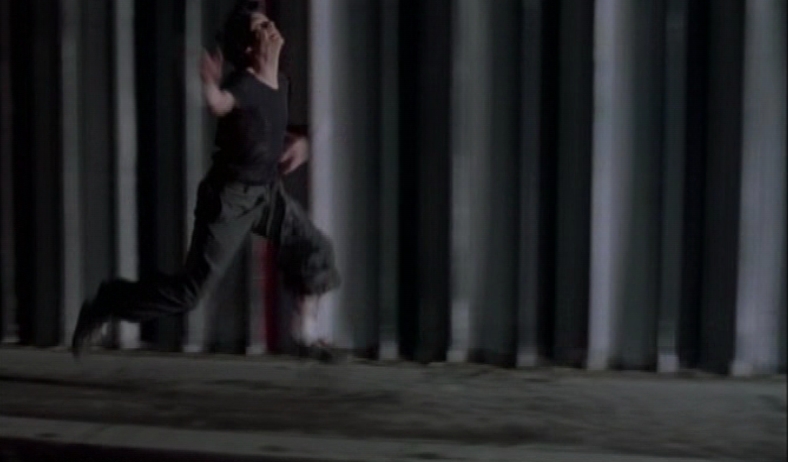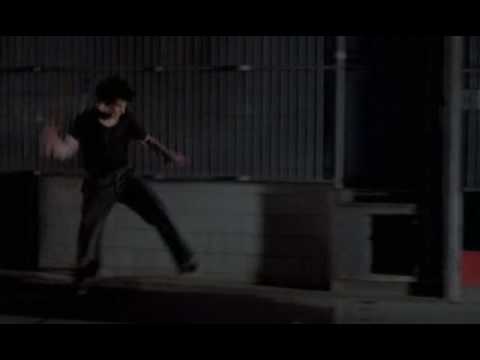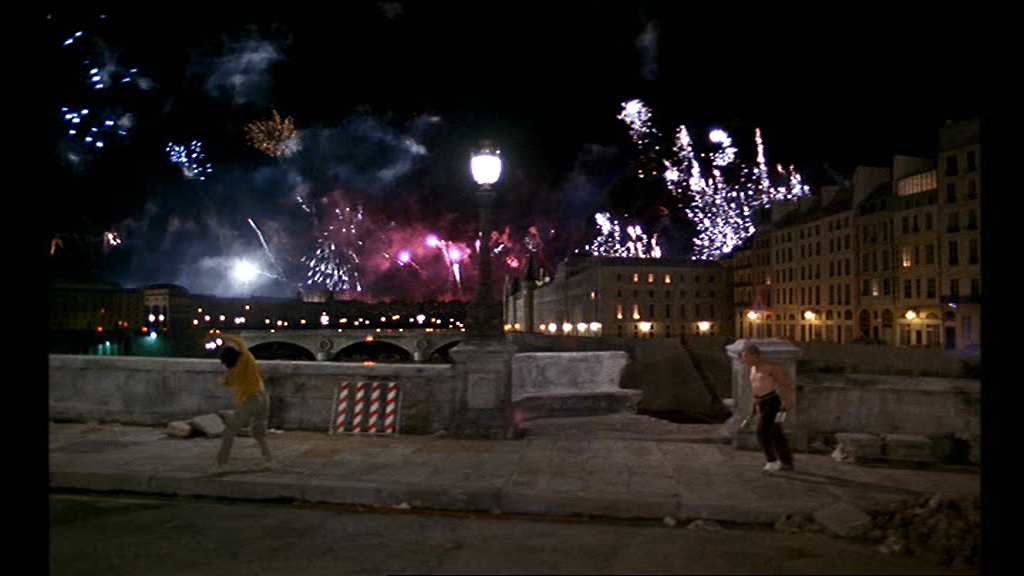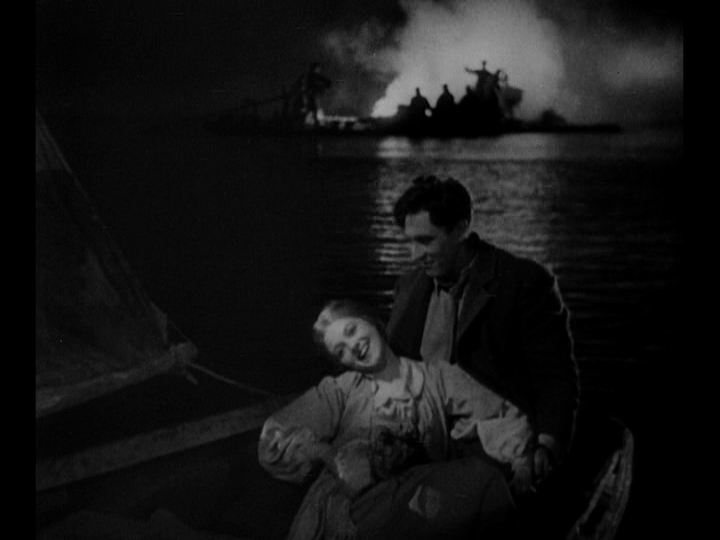From the May-June 1994 Film Comment; also reproduced in my collection Movies as Politics. (For some briefer and more recent comments about Carax’s Merde and Holy Motors, go here and here.) — J.R.
First come words. No, emotions . . .
— line overheard in party scene of BOY MEETS GIRL
Introducing André Bazin’s Orson Welles: A Critical View in the late 70s, François Truffaut registered his opinion that “all the difficulties that Orson Welles has encountered with the box office . . . stem from the fact that he is a film poet. The Hollywood financiers (and, to be fair, the public throughout the world) accept beautiful prose — John Ford, Howard Hawks — or even poetic prose — Hitchcock, Roman Polanski — but have much more difficulty accepting pure poetry, fables, allegories, fairy tales.” [Translated by Jonathan Rosenbaum, Los Angeles: Acrobat Books, 1991, 26.]
I’m not at all sure about fables and allegories — think of Campion’s THE PIANO and Kieslowski’s BLUE for two recent examples, neither of which the public seems to have much difficulty in accepting — and the Disney organization churns out fairy tales on a regular basis. But when it comes to poetry, pure and otherwise, I think Truffaut had a point. It explains not only why Welles never made a movie that was a commercial hit when it was first released but also why filmmakers as otherwise dissimilar as F. W. Murnau, Jean Vigo, Jean Cocteau, and even Jacques Tati could never belong entirely and unproblematically to the U.S. mainstream.
The problem isn’t merely poetry as a general concept, but French poetry in particular. At a panel discussion held at the New York Film Festival in 1966, Pier Paolo Pasolini, propounding his recently formulated concept of the cinema of poetry, noted, “For a literary critic, the distinction between the linguistics of prose and poetry are absolutely clear. Each one of us, just by opening a book without even reading it, understands immediately whether the book is poetry or prose.” At this point, Annette Michelson, who was sitting on the same panel, made a one-word comment: “Lautréamont” — because, as she noted later, “Lautréamont represents that point in poetry in the nineteenth century when the distinctions between poetry and prose begin to break down.” [For a more complete account of this exchange, see Film Culture , no. 42, Fall 1966, 97–100.]
In the world of the American mainstream, where Lautréamont has yet to become a viable concept, prose is still prose, hence marketable, and poetry is still poetry, hence esoteric. Yet regarding that mainstream, an interesting change in thresholds has been taking place over the past few years. With the Reaganite support of movie theater chain monopolies still in full power, the strength of independent exhibition and its alternative options — traditionally, arthouse fare and midnight movies — has been dealt a series of damaging blows. Yet at the same time, in an apparent effort to grind all the remaining Mom and Pop venues into dust, the multinationals have been attempting to broaden their and our definitions of “mainstream,” with many interesting results. A few selected examples of what used to be regarded as alternative choices — comprising a menu ranging from Twin Peaks to THREE COLORS: BLUE, or from THE PIANO to FAREWELL MY CONCUBINE — have been smeared across public consciousness like lowfat margarine. To coin a verb inspired by the distributor most interested in pursuing this all-or-nothing game, such movies have been Miramaxed — in contrast to all the alternative titles in our midst that never get mentioned in the infotainment universe, receive a minimum of free advertising (including reviews) from all branches of the media, and in general exist in public discourse to the same degree and in roughly the same way that “homeless” people (i.e., those without computers or TV sets) exist as citizens in society.
The myth that “mainstream” invariably reflects some sifting through of popular consensus is predicated on at least three bizarre assumptions: that contemporary cultural choices can operate independently of advertising, both paid and unpaid; that a viable distinction exists in most people’s minds between information and advertising; and, most operative of all in the present climate, that the publicist is always — or almost always — right. Yet when push comes to shove, the movies that people hear about are precisely those that publicists feel equipped to hype, and all the others — the films of Leos Carax, for instance — are condemned to be regarded as marginal, specialized, weird .
To what extent is mainstream status something legitimately recognized by distributors, and to what extent is it something created by promotion, including press coverage? That’s a tough question to answer, but the issue of changing thresholds remains a fascinating one. Until fairly recently, films from mainland China were deemed marginal to public interest, while films from Africa continue to be regarded that way. This is not, I would wager, an aesthetic judgment made independently by critics, but an economic one made by distributors, though it is reflected in the discourse of most mainstream critics as if it represented their own aesthetic judgment: China’s hot, Africa’s not. Souleymane Cissé’s YEELEN (BRIGHTNESS, 1987) may be one of the supreme masterpieces in film history — vastly more interesting and beautiful than the complete works of either Sydney Pollack or Brian De Palma, in my opinion — but the only way such a movie could get discussed in The New Yorker or Time or Newsweek would be if a major studio did a remake, no matter how stupid or offensive, with a bankable star like Cruise or Hanks taking over the Isiakka Kane part in blackface. The results would probably be slammed in favor of the original (at least by those critics who bothered to see Cissé’s masterpiece), but that’s probably the only way the existence of the original could ever get acknowledged in print — unless, of course, the next Cissé film got Miramaxed, which would automatically change everything. Properly speaking, most reviewers and journalists take their cues nowadays directly from distributors and publicists, and if the pressbook of our hypothetical YEELEN remake mentions the original picture, then, by golly, I guess that Cissé’s movie must exist.
Much of the discussion that follows is an inquiry into the matter of why Leos Carax, the best new French director to have come along in years, hasn’t yet been Miramaxed, and why, until or unless he does, you probably won’t get many chances to see his movies. This isn’t to suggest that Carax’s three features to date are unreleasable in the United States or that they couldn’t acquire substantial audiences here, with or without sympathetic reviews in the New York Times. In fact, his first feature, BOY MEETS GIRL, was briefly distributed by Cinecom. And when all three of his features were shown at the New York’s Walter Reade Theater late last winter as part of a Cahiers du cinéma program, I’m told that about two hundred people had to be turned away at the last screening of THE LOVERS OF PONT-NEUF. But if a deal with a distributor still hasn’t been cinched, I suspect this nonetheless has something to do with the different sort of valuation that French and stateside tastemakers place on Carax’s gifts and his poetics — comparable in some ways to the respective valuation placed on some of Godard’s recent features like NOUVELLE VAGUE (which finally “came out” in this country in video without ever having a theatrical opening). The question, in other words, is whether Entertainment Tonight and the New York Times are ready for him yet — and if they aren’t, why not.
“Anna — do you think there’s a love that burns fast, but lasts forever?'”
— Alex, in MAUVAIS SANG
One possible reason why they aren’t is that Carax’s films are simply too personal to be regarded as impersonal mainstream product — personal to the point of obsession — and too contemporary to be regarded as something we already know about, which creates problems for the publicists. All three of his features star the same lead actor, Denis Lavant, who’s roughly the same age and height as Carax and plays more or less the same character — or variations of the same character — named Alex, a sort of anarchistic street punk. (All three were produced by Alain Dahan, who died in early 1992, and all were shot by the same cinematographer, Jean-Yves Escoffier.) As David Thompson reports in the September 1992 Sight and Sound, Carax’s real name is Alexandre Dupont and “Leos Carax” is an anagram for “Alex Oscar.” The point isn’t to insist that Alex is a literal stand-in for Carax but that one feels that Carax’s work teems with coded personal references of various kinds, and these references tend to be more in the style of, say, Jean Cocteau than they are in the style of Alfred Hitchcock.
Three self-conscious examples from BAD BLOOD and THE LOVERS OF PONT-NEUF: both have characters named Hans who partially serve as father surrogates to Alex and also dispense drugs; both allude to an offscreen lover of Juliette Binoche’s character who is a doctor named Destouches, the real last name of French writer (and doctor) Louis-Ferdinand Céline, one of Carax’s favorite writers; and in both films her character rejects Alex for a much older man. Comparable recurrences are observable between BOY MEETS GIRL and BAD BLOOD; for example, in both, Alex’s best friend is named Thomas — though played by a different actor — and winds up with Alex’s girlfriend. But Carax’s features are every bit as striking for their differences as for their similarities: while Alex has a father (but no mother) in both BOY MEETS GIRL and BAD BLOOD, he pointedly lacks a background of any kind in PONT-NEUF — in contrast to the other two leading characters, both homeless, who are clearly in flight from their pasts.
In various interviews, Carax notes that he embarked on his first short film — the unfinished LA FILLE REVÉE (1978) — as a teenager in order to cast a girl he was romantically interested in at the time, and it appears that this dimension of his work has continued to be operative afterward. The female lead in his first feature, BOY MEETS GIRL, is Mireille Perrier, whom Carax was living with at the time; the female lead in the second and third, MAUVAIS SANG (BAD BLOOD) and LES AMANTS DU PONT-NEUF (THE LOVERS OF PONT-NEUF), is Juliette Binoche, whom Carax was living with at those times — although Perrier also appears in a strange cameo in MAUVAIS SANG as a young mother with a toddler, accompanied by the theme from Chaplin’s LIMELIGHT.
Other familiar bits of Carax lore: As a child or young teenager, he went for long periods without speaking (something also true of Alex in MAUVAIS SANG, who is ironically nicknamed “Chatterbox” as a consequence), and during one of these periods, he discovered, at the Cinémathèque Française, the silent cinema, which remains a central source of inspiration in his work. (Among his favorite directors of the silent period are Griffith, Vidor, and Jean Epstein.) His most prominent mentors and role models appear to be Godard and Philippe Garrel — the latter a relatively unknown figure in the United States who is also a “child” of the Cinémathèque, a lover of silent cinema with a taste for eclectic experiment and “pure” emotion, and a director obsessively preoccupied with his own actresses.
Clearly the romance of the couple is at the center of Carax’s poetic universe, regardless of whether it figures in a given case as a realized fact or as a Platonic ideal. The first two Carax features largely consist of a discontinuity of separate scenes, uncertain gestures, and fragments of ideas until Alex and the heroine finally get together — boy meets girl — and something more fluid and potent and sustained and even awesome takes hold. This “something” is not really a narrative — Carax isn’t much of a storyteller, at least by American standards (though he improves a great deal in this respect in THE LOVERS OF PONT-NEUF) — but, rather, a delirious and lyrical form of nonnarrative consisting of cascading and overlapping poetic conceits, explosions of feeling, and pure sensation. “Story” in a Carax movie up to now has basically been a matter of what becomes necessary to bring a couple together and start these fireworks (figurative or literal), and what ensues in the world as a result of their remaining together or their drifting apart.
Rarely do poetics and libido coexist in movies quite as nakedly and as shamelessly as they do in Carax’s, and the anarchic and often amoral implications of this l’amour fou are never backed away from: all of Carax’s lovers are fully capable of committing murder, and do so if the spirit moves them. The opening event of THE LOVERS OF PONT-NEUF — a car running over Alex’s leg as he lies drunkenly stretched out on Paris’s Boulevard Sebastapol, which also occasions the heroine’s first encounter with him — is subtly but unmistakably brought about by the distracted self-absorption of the lovers in the car, whom we glimpse only elliptically. And for all the tenderness with which the film regards Alex’s feelings for Michelle (Juliette Binoche), a slumming middle-class artist who is progressively losing her eyesight, it is also tough and unsentimental about his desire for her to remain both blind and poor, so he can keep her. (If the plot recalls CITY LIGHTS in some particulars, it is Chaplin fully revised and updated by contemporary posthumanism.)
Bringing the couple together is not necessarily an easy matter either. In BOY MEETS GIRL, a veritable eternity has to pass before this happens. In BAD BLOOD, one has to wait for nearly half the movie, and after an extended sequence during which the couple spends an intense if sexless night together, the movie more or less returns to the doldrums (specifically, to relatively shopworn allusions to other thrillers, heist movies, or Godard movies like PIERROT LE FOU and ALPHAVILLE that allude to these genres — or else to freakish variations on these models, like Alex holding himself as hostage during the heist when he’s surrounded by police, holding a gun to his own head). Happily, in THE LOVERS OF PONT-NEUF, the couple meets right away, which is one of the reasons why this feature represents a quantum leap over the two preceding it.
Another reason for the special status of THE LOVERS OF PONT-NEUF in Carax’s work is that it partakes of one of the most potent poetic ideas ever dreamed up for movies — an idea that has particular links with French cinema but that can also be traced back to many of the greatest silent films made anywhere: The City as Plaything. In such touchstones as LES VAMPIRES; PARIS QUI DORT (THE CRAZY RAY); BERLIN, SYMPHONY OF A CITY; THE MAN WITH THE MOVIE CAMERA; THE CROWD; SUNRISE; LONESOME; PARIS BELONGS TO US; ALPHAVILLE; PLAYTIME; FOUR NIGHTS OF A DREAMER; OUT I; and CELINE AND JULIE GO BOATING — not to mention DIVA, NIGHT AND DAY, and (to take a less obvious example, where “city” becomes over 400,000 young people camped out on a farm pasture) WOODSTOCK — the city is posited as a gigantic whirling and humming toy, mysterious and luminous. In many of these examples, it seems to exist mainly for the amusement of children, lovers, and other small conspiratorial groups harboring their own special codes and secrets.
What is it that makes Paris a city uniquely suited for stimulating and rewarding such fantasies? Speaking as one fortunate enough to have lived in that city for five years — only a couple of blocks away from the Pont-Neuf, in fact, which represents the magical, spectatorial vantage point in both FOUR NIGHTS OF A DREAMER and PONT-NEUF — I would say that the very mise en scène and mise en place of the city’s appointments encourages one’s imagination to drift in such dreamy directions. The night lighting of buildings, streets, bridges, and statutes — not to mention river boats — is quintessentially theatrical, and anyone who has ever sat at a Parisian café table facing a street during the day or night has had an experience somewhat akin to a theatergoer sitting in an orchestra seat before an ongoing spectacle. Paris is the only city I know where everyone is encouraged to stare in public situations, and certainly a city where there’s always plenty to stare at.
There’s also something specifically Cartesian about the French sense of fantasy in relation to the life of the mind, a conceit implying that anything you can think has to be real on some level. (This has negative as well as positive consequences in Carax’s work. In BAD BLOOD, for example, having certain attitudes toward various action genres — heist movies and thrillers, for instance — is viewed as if this were the equivalent of making a heist movie and thriller, a common form of false syllogism in French filmmaking.) When we clamor for verisimilitude in Anglo-American movies, what we generally mean by “real” is some form of ideological construction that we’d just as soon not have to think about directly. By contrast, when a missing person poster for Michelle (Juliette Binoche) suddenly turns up all over Paris in PONT-NEUF — a poster so “unbelievably” widespread and endlessly reproduced that one is made to feel briefly that no other poster exists in the city — the outlandishness is poetically apt, because it corresponds to the paranoid sense of threat that Alex feels about the world impinging on his love, an overwhelming emotional reality that is no less valid than the more mundane physical reality an American director would be more likely to honor. (Far more American — even Hawksian — is a speech by Hans about how women, with their vulnerability to rape and beatings, their periods and whatnot, don’t belong on Pont-Neuf, which he and Alex have cordoned off as their own preserve while this bridge is under repair. The fact that this all turns out to be because Michelle reminds Hans of his long-lost wife is more Hawksian still.) Perhaps even more striking, given the grand scale of the movie’s Pont-Neuf set (built in the south of France) and the overall monumentality of its view of Paris, is the fact that it’s essentially only a three-character story, with the spectacular made to feel private and intimate at every turn.
Fantasy of this Cartesian kind is common enough in French movies (though check out the neglected and very great 1933 musical HALLELUJAH I’M A BUM for the nearest Hollywood equivalent). What seems less common is Carax’s insistence on placing such a fantasy within the same overall continuum as a documentary depiction of the homeless in Paris. More specifically, the film virtually begins with a sequence showing Alex, after the car runs over his leg, being taken by the police to a shelter for the homeless along with others who are clearly real homeless people and not actors. For American tastes, such neorealism about the homeless doesn’t mix with heady fantasies about three fictional homeless characters that dominate the remainder of the movie — fantasies that include the capacity to sneak into the Louvre one night to peer at a Rembrandt canvas by candlelight and then make love on the museum floor. Yet surely if quasi-documentaries about the homeless spring from the same sources as fantasies about them, they should be allowed to coexist on the screen as well.
Indeed, part of what makes Carax’s poetry subversive in relation to American sensibilities is its refusal of certain boundary lines that we establish in relation to fantasy and poetry. In THE LOVERS OF PONT-NEUF these boundary lines relate to the homeless; in BAD BLOOD, more daringly, they relate to AIDS. According to the quasi-fantasy plot of BAD BLOOD, Alex, a petty criminal and card sharp, is asked to replace his recently deceased father in a planned theft from a drug company of a virus that offers the only known cure for the deadly disease STBO — a disease “transmitted by caresses” that is said to develop from “love without love” (“the younger you are, the higher the risk”) and to infect both partners “even if only one partner makes love without love.”
I suppose this poetic conceit could be called insensitive, and perhaps even tasteless, toward people who have AIDS and ARC. But to call it “homophobic,” as some critics have, seems a clear case of political correctness running amok (or at least awry), particularly if one considers that no gay sex figures in the plot. There is a certain amount of homoeroticism in scenes that show Alex with Marc (Michel Piccoli) and Hans (Hans Meyer), the two older crooks, when all three are going around shirtless in the summer heat, conjuring up an ambience of closet homosexuality that evokes the American-style macho thrillers of Jean-Pierre Melville — a style, one might add, in which homophobia sometimes appears to be barely a kiss away. But to equate Carax’s AIDS-inspired fantasy with homophobia simply because he isn’t gay is to fall into a dubious kind of contemporary tribalism whereby AIDS becomes the exclusive intellectual and artistic “property” of people who practice homosexual sex and those who appoint themselves to speak for them — an attack roughly equivalent to charges made against William Styron, a non-Jew, for positing a non-Jew as the tragic heroine of a novel about the Holocaust in Sophie’s Choice . (“How dare he write a novel about my/their Holocaust!” seems the unconscious subtext of such a complaint, which doesn’t necessarily come from concentration camp survivors.) And in the case of Carax and BAD BLOOD, it might be argued that the specter of dangerous sex is so central to the emotional cast of the whole movie that however one judges Carax’s articulation of it, the theme can’t be written off as a frivolous adjunct to what the movie is about; it even accounts for why Alex and Marc’s girlfriend Anna (Binoche) never have sex during their long vigil together, the most vibrant stretch of the movie.
. . . . (see again Laughton’s extraordinary THE NIGHT OF THE HUNTER if you want to grasp what the film orphan is: the spectator’s identification can’t go any deeper than with the character of the orphan, the child alone in the darkness).
— from Carax’s review of PARADISE ALLEY
Still in his teens (he was born in Suresnes, France, to a French father and an American mother in 1960), Carax made half a dozen critical contributions to Cahiers du cinéma in 1979–80, shortly after starting to make his first short (which was never completed). He began with a passionate defense of PARADISE ALLEY, Sylvester Stallone’s first film as a writer-director, then went on to publish one film festival report (Hyères, including a celebration of a Robert Kramer retrospective), a brief réportage on the shooting of Godard’s SAUVE QUI PEUT (LA VIE), an article about a program of new and old Polish films at the Cinémathèque (Zanussi, Skolimowski . . .), a terse put-down of the French feature C’EST ENCORE LOIN L’AMÉRIQUE, and a brief review of Stallone’s ROCKY II. A year and a half after the last of these, Olivier Assayas reviewed Carax’s short film STRANGULATION BLUES at Hyères. Since then, the most significant Carax texts in Cahiers have been an extended dialogue with Philippe Garrel in no. 365 (November 1984), an interview about MAUVAIS SANG in no. 390 (December 1986), and a special issue of the magazine devoted to LES AMANTS DU PONT-NEUF, published as a supplement to no. 448 (October 1991) — edited by Carax himself, and consisting mainly of illustrations. (He has also appeared as Edmund in Godard’s KING LEAR [1987] and as himself in Garrel’s LES MINISTÈRES DE L’ART [1988].)
The most important of Carax’s critical pieces is undoubtedly the first. Fascinated with both the pessimism and the nightmarishness of Stallone’s 1978 feature (no doubt assisted by the film’s French title, LA TAVERNE DE L’ENFER) — a grim wrestling story about three grown orphan brothers in Hell’s Kitchen in 1946 — Carax writes about both the plot and the film’s texture as if he’s recounting an orphan’s nightmare, clearly responding to both the physicality and the bleak finality of Stallone’s vision in spite of the movie’s humor and its happy ending: “The characters struggle to arrive at the end of each sequence and Stallone’s camera doesn’t come to their assistance — quite the contrary. . . . In Stallone’s cinema, each shot triumphs or loses.” Checking out the movie for the first time recently on video, I found it easy enough to see the infernal singularity Carax was writing about; after all, this is an expressionist, doom-ridden movie in which an impoverished black wrestler drowns himself on Christmas Eve because he’s happy and where the climactic, $9,000 wrestling match in Paradise Alley, a sleazy nightclub, gets carried out in a driving rain because the establishment has serious leaks in its roof.
One can’t say that Carax was the only critic to have responded to Stallone’s style (see, for instance, Richard Combs’s perceptive review in the March 1979 Monthly Film Bulletin), but the nature of his response as a teenage critic in relation to both the physicality and nostalgie de la boue (taste for lowlife; literally, “yearning for the mud”) of his subsequent movies is still worthy of notice. In BOY MEETS GIRL — the first and perhaps the least of his features, certainly the most morose and unrelievedly nocturnal, shot in high-contrast black and white — the same sort of suicidal depression, no doubt influenced in particular by the youthful despair in Bresson’s THE DEVIL, PROBABLY (1977), seems everywhere apparent.
Perhaps the most striking things about MAUVAIS SANG and LES AMANTS DU PONT-NEUF are how they were made. Both had a shooting schedule of about thirty weeks. (In the case of PONT-NEUF, thanks to various technical and financial problems, the thirty weeks came in three separate stages, beginning in August 1988 and ending in March 1990.) Both were mainly shot in makeshift studios constructed specifically for these films. And both are quite clearly movies that are not generated by strictly filming preexisting scripts; they entail a kind of ongoing improvisation with actors, sets, and day-to-day inspirations that seems to have more in common with the sources of certain early silent pictures than with those of most movies being made today. Without this freedom, one doubts that the more remarkable qualities of the actors could flourish: Lavant’s emulations of Peter Lorre (a Carax favorite) and his spastic-expressionist body language; Binoche’s ability to suggest early Anna Karina in BAD BLOOD or her awesome capacity to look like a different person in almost every shot of PONT-NEUF.
This is perhaps the most pertinent attribute distinguishing Carax from the two other “punkish” French filmmakers with which he’s most often (and often unfairly) linked — the much older Jean-Jacques Beineix (DIVA, BETTY BLUE) and the much callower Luc Besson (SUBWAY, LA FEMME NIKITA), both of whose links to earlier cinema seem principally an acquaintance with various Hollywood tropes, not the poetics of a Jean Epstein or a Jean Grémillon (whose LA PETITE LISE is evoked more than once, and briefly glimpsed, in BAD BLOOD). At best, Beineix and Besson are notable for the ways they fulfill certain scenarios, not for their wild journeys into the unknown; it’s hard to believe that either would ever think of repeating a shot precisely or momentarily cutting off the sound track to achieve their poetic effects, as Carax does in BAD BLOOD and PONT-NEUF, respectively.
The cinema is an anti-universe where reality is born out of a sum of unrealities.
— Jean Epstein
What is it about expressionism and surrealism, at least in their original European forms, that apparently make them anathema to the American mainstream? When German expressionism first encountered Hollywood technology in 1927, it yielded one of the greatest of all silent pictures, F. W. Murnau’s SUNRISE (1927) — a masterpiece that is recalled more than once in THE LOVERS OF PONT-NEUF — but a movie that also [reportedly] flopped at the box office, no matter how much it impressed and influenced directors like John Ford and Howard Hawks in their own work. Since then, it’s questionable whether other instances of Hollywood expressionism have ever rung many cash registers outside of those in Disney animated features like SNOW WHITE AND THE SEVEN DWARFS and PINOCCHIO. Some, like CITIZEN KANE, THE 5000 FINGERS OF DR. T, ERASERHEAD, or BRAZIL (to cite four rather unequal and dissimilar examples), have racked up extensive critical and/or cult reputations, but the mass public has generally been scared away. (I’m not counting the comic-book reductions and dilutions of this style, as in Tim Burton’s movies.) And when it comes to surrealism, the record is not much better. Shorn of most or all of its antibourgeois political program, it makes certain inroads in the lighthearted fantasies of René Clair’s 40s Hollywood comedies, the lurid imaginings of Sternberg’s THE SHANGHAI GESTURE, the giddy dreamlike rhythms and spatial continuities of Albert Zugsmith’s overlooked CONFESSIONS OF AN OPIUM EATER/SOULS FOR SALE, and the pornographic thrillers of David Lynch, among other places, but it rarely becomes both commercial and permissible in its more dangerous forms.
Carax’s poetics depend mightily on memories of both of these European styles, especially in THE LOVERS OF PONT-NEUF. When Alex and Michelle get drunk together for the first time, the giant liquor bottles that we glimpse lying beside them on the pavement seem to partake of both traditions, suggesting both a surrealist fantasy à la Magritte and a drunken expressionist vision à la James Ensor or Franz Marc. When Alex sets fire to dozens of posters with Michelle’s face that flank both sides of a métro passageway, the conceit recalls the disembodied hands clutching candelabras in the hallway in Cocteau’s BEAUTY AND THE BEAST. More generally, PONT-NEUF might be said to recall every studio-built Paris from AN AMERICAN IN PARIS to FUNNY FACE to “Le Dernier Réveillon” (the first episode of LE PETIT THÉÂTRE DE JEAN RENOIR, about a romantic couple of starving beggars) to the lovely Alexandre Trauner sets in ROUND MIDNIGHT; but at their most hyperbolic, Carax’s aesthetics seem to owe even more to paintings.
What they seem to owe to the silent American cinema, above all, is their raw sense of physicality. The exhilarating athleticism of the parachuting sequence in BAD BLOOD and the waterskiing sequence in PONT-NEUF, with the actors plainly doing their own stunt work in spectacular surroundings, evoke Douglas Fairbanks and Buster Keaton, but these are only the most blatant examples of a cinema of untrammeled gestures and acrobatic exertions. When Marc and Charlie (Serge Reggiani), an old crony who runs a parachuting club, greet one another at an airplane hangar in BAD BLOOD, this becomes the occasion for a brief, wild interlude of barks and mimed violent threats between the two men in silhouette — a kind of drunken Punch and Judy show that suddenly unfolds between blackouts. When Alex, in the same film, is trying to get Anna (Binoche) to stop crying, he proceeds to enact a kind of circus vaudeville that begins with ventriloquism (a trick he resorts to elsewhere in the film), proceeds with goofy pantomime and fire-eating (a trick he reprises at length in PONT-NEUF), and concludes with tossing up apples that eventually become transformed into a torrential rain of vegetables crashing down on him. Most dazzling of all, to the strains of David Bowie’s “Modern Romance” on a radio, Alex walks outside the butcher shop where he and Anna are hanging out, and, accelerating his movements and contorted postures to the music, he walks, limps, runs, jumps, turns, spins, and does cartwheels for what seems like several city blocks, the camera dizzily following him all the while.
A similar choreography transpires on the Pont-Neuf with Alex and Michelle during the bicentennial July 14th fireworks display while a transistor radio blares out everything from Arabian pop music to a Strauss waltz. It’s an ecstatic expressionistic moment that, for me, evokes not only the Luna Park fireworks in SUNRISE, but another one of that picture’s ecstatic moments that occurs shortly afterward. Janet Gaynor and George O’Brien, the rural hero and heroine, happily reunited after a crisis in their marriage, return from the city at night in a makeshift sailboat, and briefly pass a raft on which other country folk dance wildly around an open fire. As Gaynor giddily rocks her head back and forth to the Gypsy-like music, which momentarily overlaps with the slower romantic theme in Hugo Riesenfeld’s multilayered score, creating a brief cacophonous overload, this superb externalizing of the couple’s sexual bliss in a passing narrative detail — both seen at once in separate portions of the frame as they drift off in opposite directions — has the same kind of wanton, lyrical abandon that Carax reaches for and often achieves in his own movies. Though the American public mainly didn’t buy such poetry back in 1927, and the lack of hygienic glamour in Alex and Michelle may scare off Entertainment Tonight‘s style consultant today, the sublimity of such moments describes precisely what we aren’t getting right now in stateside movies, Miramaxed and otherwise, and what we sorely need. But no need for despair: PONT-NEUF closes with a promise from Carax, and a threat: “Let Paris rot!” As a barge carrying Alex and Michelle leaves the capital of pain for Le Havre and the Atlantic, the overall implication is not merely a reminder of Vigo’s L’ATALANTE but also a suggestion that Carax may be making the United States his next cinematic port of call. If so, let’s hope he doesn’t get held up indefinitely in customs.
— Film Comment, May-June 1994
For sharing their observations, their erudition, and in some cases their issues of Cahiers du cinéma or their videos, the author wishes to thank Michael Almereyda, Cecilia Burokas, Natasa Durovicová, David Ehrenstein, Bill Krohn, Lorenzo Mans, Richard Peña, and Alan Williams.

